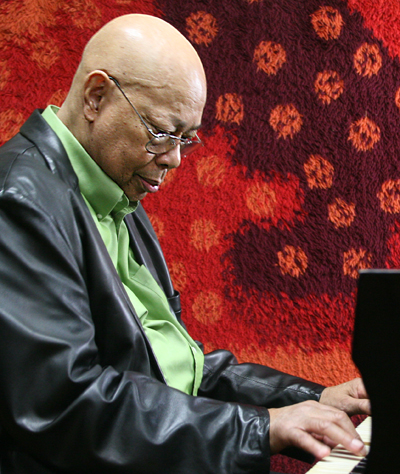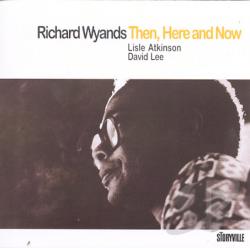Yes It Is – Richard Wyands
This syncopated swinger makes a great piano feature but sounds equally exciting with a horn on the melody. It's remarkably versatile as shown by the three very different approaches we've featured here, with an exclusive MP3 track available from the most recent recording of composer Richard Wyands in a duo with then-15 year old bassist Daryl Johns! Check out our video footage of this collaboration.
- Recording: Richard Wyands - Then, Here And Now
- Recorded on: October 12, 1978
- Label: Storyville (SPL 4083)
- Concert Key: B-flat
- Vocal Range: , to
- Style: Swing (medium up)
- Piano - Richard Wyands
- Bass - Lisle Atkinson
- Drums - David Lee
Video
- Description
- Historical Notes
- Solos
- Piano Corner
- Bass Corner
- Drum Corner
- Guitar Corner
- Inside & Beyond
- Minus You
Related Songs
Email Send Yes It Is to a friend
- Recording: James Spaulding - Smile Of The Snake
- Recorded on: December 3, 1996
- Label: HighNote (HCD 7006)
- Concert Key: B-flat
- Vocal Range: , to
- Style: Swing (medium up)
- Alto Sax - James Spaulding
- Piano - Richard Wyands
- Bass - Ron McClure
- Drums - Tony Reedus
Video
- Description
- Historical Notes
- Solos
- Piano Corner
- Bass Corner
- Drum Corner
- Guitar Corner
- Inside & Beyond
- Minus You
Richard played two original compositions on his 1978 Jazzcraft trio session. Yes It Is and Lenora. James Spaulding thought both compositions would sound good on his album, so he included both, electing to play flute on Lenora.
Related Songs
Email Send Yes It Is to a friend
- Recording: Richard Wyands - Richard Wyands - Daryl Johns Duo
- Recorded on: August 7, 2011
- Label: jazzleadsheets.com (JLS 1014)
- Concert Key: B-flat
- Vocal Range: , to
- Style: Swing (medium)
- Piano - Richard Wyands
- Bass - Daryl Johns
- Description
- Historical Notes
- Solos
- Piano Corner
- Bass Corner
- Drum Corner
- Guitar Corner
- Inside & Beyond
- Minus You
Don Sickler, arranger: "A good piece of music can usually work at a variety of tempos. As a duo, I heard this piece as a medium swinger as opposed to a medium up swinger. Richard's original introduction was designed to feature drums. I thought this would also work great featuring the bass, letting Daryl get a little solo space in right away. The bass then plays the first six measures of the melody, also playing roots in the fourth measure of punctuated chords. The melody has nice little holes, originally for drum fills, which I had a lot of fun developing into written bass fills. The bass also plays the melody with the piano in the sixth measure of the B section, which James Spaulding left for piano alone in his quartet recording."
Don Sickler, arranger: "I mentioned to Richard that I was always on the lookout for compositions that could be arranged to feature the bass player in a melody role. I could hear three of Richard's compositions arranged in this fashion, so I told him about the young bassist Daryl Johns. Daryl was only 14 at the time of this discussion. Richard gave me his blessing to arrange what I heard, so we took Richard and Daryl to Rudy Van Gelder's Recording Studio and recorded and filmed three of Richard's compositions. This is the first one to come out, to be followed by Dee's Den and Blues Scam."
Call and response, question and answer, antecedent and consequent; they all refer to a universal principle with which we are all familiar. Composers and improvisers alike understand its value, but sometimes it can be challenging to successfully incorporate this into our work. Yes It Is utilizes this technique so well that it can't be told who is the lead and who is the accompaniment; the two voices are playing a game of catch so effortlessly that the ball glides back and forth on its own, uninhibited by whomever is throwing or catching.
This piece is a phenomenal educational device, for it works on almost every instrumental skill there is. To start, the introductory section requires rhythmic precision as well as control of articulation. The first quarter note of each phrase must be played in an even staccato manner that is stopped directly on beat two. The second note, an eighth note on the 'and' of two must be held out for only its exact length, while the third and final note is a quarter tied to another quarter, extending into beat one of the following measure. Just getting the accuracy required here can take time and devotion. Yet, the subsequent three bars of this phrase are an open solo on a few minor tonalities. The combination of tight-structured, precise and logical rhythm with loose, wide-ranging solo improvisation is a key component to what makes jazz such a vital art form.
The A section is an eighth-note-laden passage that forces the player to perform both a lead line in the upper register as well as make some crucial rhythmic hits in the lowest register. Most songs do not have the performer doing these two opposing tasks simultaneously, so this will develop the player's understanding of how to perform numerous roles at once; funnily enough, having to do two tasks at once increases your concentration abilities, enabling you to have an easier time when you have to perform just one of the tasks.
The B section demands that you lock down and get in the pocket, the most important aspect of Jazz Bass playing! The performer must do this with a variety of note lengths, articulations, and phrase structures. The melody from A returns, but this time its ending is different. Lastly, at D there is a push and pull between consecutive bars of "2 Feel" and apreggiated eighth notes that ends with one bar of walking leading into the solos. Literally, this piece forces you to show how developed your musicianship is; It redefines bass feature!
If you're a band director looking for a positive, constructive challenge for a talented high school player or a professional looking to sharpen your skills, we sincerely hope that you enjoy this highlighted selection. Yes It Is will tune up any player's' skills, increasing musicianship by the minute!
Don Sickler, arranger: "A good piece of music can usually work at a variety of tempos. As a duo, I heard this piece as a medium swinger as opposed to a medium up swinger. Richard's original introduction was designed to feature drums. I thought this would also work great featuring the bass, letting Daryl get a little solo space in right away. The bass then plays the first six measures of the melody, also playing roots in the fourth measure of punctuated chords. The melody has nice little holes, originally for drum fills, which I had a lot of fun developing into written bass fills. The bass also plays the melody with the piano in the sixth measure of the B section.
"I thought this piece would be fun for bass players to add to their repertory, giving them a piece where they could share the melody responsibilities. I was glad Richard let me arrange it in that way. Richard said he loved recording it himself with Daryl."
Related Songs
Email Send Yes It Is to a friend

Richard Wyands
July 2, 1928 – September 25, 2019
Richard Wyands is a remarkably gifted and precocious musician who is best known as a sideman. A native of Oakland, California, he started playing piano in local clubs in San Francisco when he was only sixteen years old, at which time he became a union member (with a sponsor, of course, due to his youth). Since the 1950s, he has played alongside some of the greatest and best-known American jazz musicians, such as Charles Mingus and Roy Haynes. Read more...





